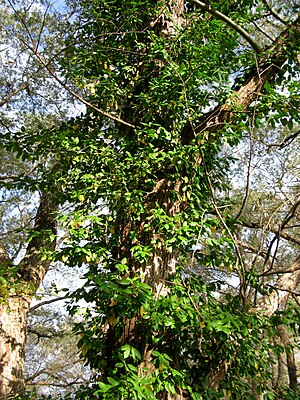Climbing spindle bush
| Climbing spindle bush | ||||||||||||
|---|---|---|---|---|---|---|---|---|---|---|---|---|

Climbing spindle bush ( Euonymus fortunei ) |
||||||||||||
| Systematics | ||||||||||||
|
||||||||||||
| Scientific name | ||||||||||||
| Euonymus fortunei | ||||||||||||
| ( Turcz. ) Hand.-Mazz. |
The climbing spindle bush ( Euonymus fortunei ), also known as the creeping spindle , is a plant belonging to the genus of the spindle bushes .
description
The climbing spindle shrub grows as an evergreen , ascending or creeping subshrub , whereby the size of dwarf forms varies up to about 10 meters in height. The branches are round, brown to brown-green, sometimes striped and densely covered with leaves . These are hairless and ovate to ovate-elliptical with a slightly notched to sawn edge, blunt to wedge-shaped base and blunt to pointed tip. They are 2 to 5.5 inches long, 2 to 3.5 inches wide and either sitting or provided with a 2 to 9 millimeter long petiole. The inflorescences bear a few four-fold flowers with a diameter of about 5 millimeters, which sit on 5 millimeter long stems. The sepals are semicircular, the whitish or greenish petals almost spherical. Brown to reddish brown capsules with red aril are formed as fruits .
If there is a climbing facility, the spindle bush can climb up to 20 m. Like ivy , the spindle shrub as an evergreen climbing plant forms adherent roots and initially exists in a sterile youth or climbing phase. When a height with sufficient light conditions is reached, the fruit-bearing phase begins and no more adherent roots are formed.
The frost hardiness is −20 ° C.
Occurrence
The species occurs in forests and bushland in South and Southeast Asia from Pakistan to Japan , Indonesia and the Philippines , where it grows on earth or rocky subsoil and occurs at altitudes of up to 3400 m.
In horticultural culture, the species and, in particular, its cultivated forms that are adapted to the respective climate are widespread worldwide, with the exception of arctic-continental and arid climates.
There is a similarity to the Euonymus japonicus , which is also often planted as an ornamental shrub, but does not develop climbing roots. They are related to similar species such as Euonymus theifolius and Euonymus vagans .
use
The climbing spindle bush is used as a ground cover , in hedges or for facade greening . Numerous cultivars with different looks and different climatic requirements have been bred. In Central and Western Europe, forms with white and yellow ( variegated ) leaves (e.g. Euonymus fortunei 'Emerald Gold', Euonymus fortunei 'Gracilis') form the focus of production, as they are used in large numbers for planting graves.
Picture gallery
proof
- ↑ a b Entry in the Flora of China (English)
- ↑ a b Overview climbing plants , In: Fassadengrünung-Polygrün.de
- ↑ Euonymus japonicus Thunberg . In: Flora of China .
- ↑ Michael Dirr: Dirr's Hardy trees and shrubs: an illustrated encyclopedia . Timber Press, 1997, ISBN 978-0-88192-404-6 , pp. 151 .






